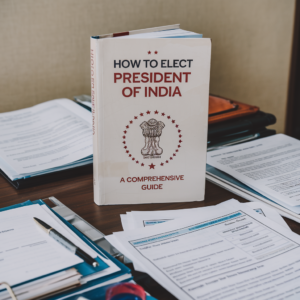The President of India serves as the head of state and the supreme commander of the Indian Armed Forces. Holding a key position in the country’s democratic framework, the president represents the unity and integrity of the nation. Understanding how to elect President of India is essential, as this process follows a unique, structured approach laid down in the Constitution.
History of the Presidential Office
The President of India’s office was instituted on January 26, 1950, marking the nation’s transition to a republic with the adoption of its Constitution. The president serves as the constitutional head of the executive, acting on the advice of the Council of Ministers while upholding the provisions of the Constitution.
Eligibility Criteria for Presidential Candidates
According to Article 58 of the Indian Constitution, a candidate must meet the following requirements to be eligible for the office of the President:
- Must be a citizen of India.
- Must be at least 35 years old.
- Must be eligible to become a member of the Lok Sabha.
- Must not hold any office of profit under the Government of India, any state government, or local authorities.
Individuals Allowed to Contest
Certain office-holders, however, can contest the election while in office. These include:
- The Vice-President of India
- The Governor of any Indian state
- A Union or State Minister, including the Prime Minister and Chief Ministers
Conditions for Holding the Office of President
Under Article 59, specific conditions apply to the role:
- The president must not be a member of either house of Parliament or any State Legislature.
- The president must not hold any other office of profit.
- The president is entitled to an official residence and various allowances set by Parliament.
- The salary and allowances of the president cannot be reduced during the term in office.

How to Elect President of India: The Election Process
Electoral College Composition
The President of India is elected through an indirect election by an Electoral College that consists of:
- Elected members of both houses of Parliament (Lok Sabha & Rajya Sabha)
- Elected members of State Legislative Assemblies (MLAs) from all Indian states
- Elected members of Legislative Assemblies of Union Territories (Delhi, Jammu & Kashmir, and Puducherry)
The nominated members of the Parliament and State Legislatures do not participate in the election.
Nomination Process
For a candidate to be considered in the presidential election, they must:
- Secure the backing of at least 50 proposers and 50 seconders (MPs/MLAs).
- Submit a security deposit of ₹15,000 to the Reserve Bank of India (RBI).
- If the candidate fails to secure at least one-sixth of the votes, the deposit is forfeited.
Voting Procedure
The election follows the Proportional Representation System using the Instant-Runoff Voting (IRV) method. The process involves:
- Secret Ballot Voting – Each elector votes confidentially.
- Weighted Votes System – Each vote carries a certain value based on:
- The population of the respective state (as per the 1971 Census).
- The number of elected representatives in the State Legislative Assembly.
- The equal distribution of votes among MPs.
The formula for calculating the value of an MLA’s vote: (Total population of the state ÷ Total number of elected MLAs) ÷ 1000
The formula for calculating the value of an MP’s vote: (Total value of all MLA votes ÷ Total number of elected MPs)
Counting of Votes
- The candidate must secure more than 50% of the total valid votes to be elected.
- If no candidate secures the majority, the candidate with the least votes is eliminated, and their votes are transferred based on second preferences. This process continues until a clear winner is determined.
Role of Political Parties
While MPs and MLAs participate in the voting process, they usually vote according to their party’s preference. However, the voting remains secret, allowing them the option to vote based on their independent choice.
Importance of the Presidential Election in India
The president’s election process ensures fair representation from both national and state levels. Unlike direct elections, this method prevents political instability and ensures that the elected individual can function as an impartial guardian of the Constitution.
Conclusion
Understanding how to elect President of India highlights the country’s commitment to democratic values. The electoral college system, proportional voting, and rigorous eligibility criteria ensure that only the most qualified candidates assume this esteemed position. By upholding the sanctity of the Indian Constitution, the process continues to strengthen the nation’s democratic framework.


